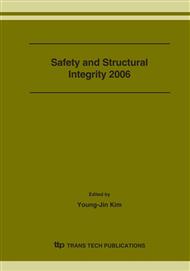p.15
p.21
p.25
p.31
p.37
p.43
p.49
p.71
p.77
Failure Probability Estimation of Pressure Tube Using Failure Assessment Diagram
Abstract:
Pressure tubes are major component of nuclear reactor, but only selected samples are periodically examined due to numerous numbers of tubes. Pressure tube material gradually pick up deuterium, as such are susceptible to a crack initiation and propagation process called delayed hydride cracking (DHC), which is the characteristic of pressure tube integrity evaluation. If cracks are not detected, such a cracking mechanism could lead to unstable rupture of the pressure tube. Up to this time, integrity evaluations are performed using conventional deterministic approaches. So it is expected that the results obtained are too conservative to perform a rational evaluation of lifetime. In this respect, a probabilistic safety assessment method is more appropriate for the assessment of overall pressure tube safety. This paper describes failure probability estimation of the pressure tubes using probabilistic fracture mechanics. Failure assessment diagram (FAD) of pressure tube material is proposed and applied in the probabilistic analysis. In all the analyses, failure probabilities are calculated using the Monte Carlo simulation. As a result of analysis, failure probabilities for various conditions are calculated, and examined application of FAD and LBB concept.
Info:
Periodical:
Pages:
37-42
Citation:
Online since:
February 2007
Authors:
Price:
Сopyright:
© 2007 Trans Tech Publications Ltd. All Rights Reserved
Share:
Citation:


